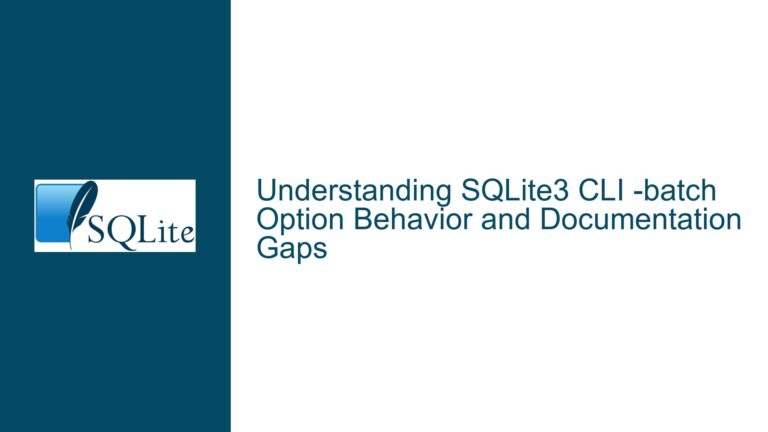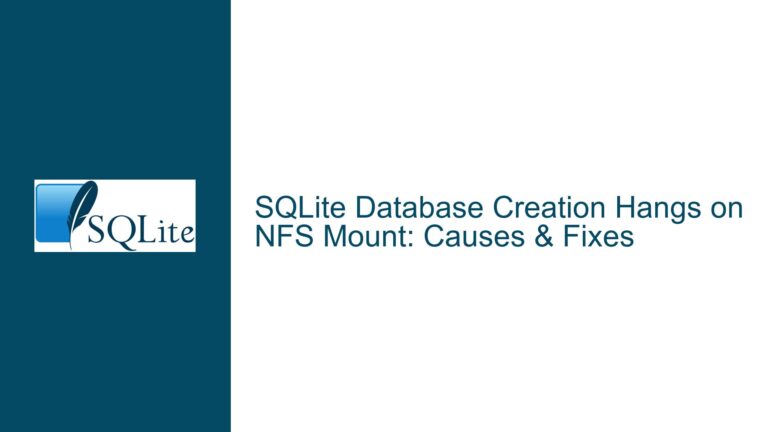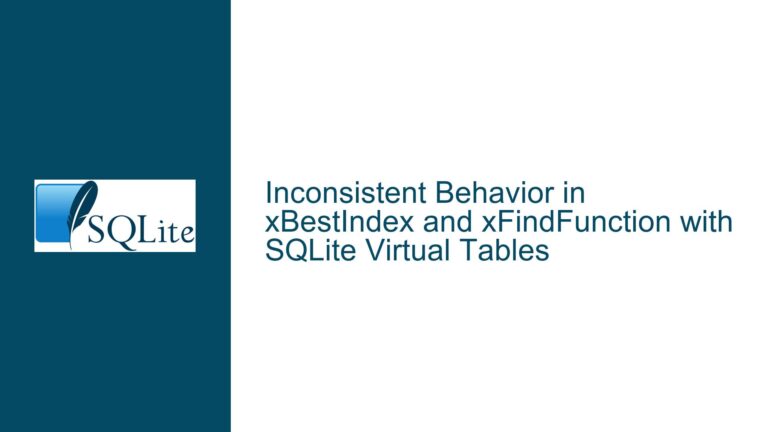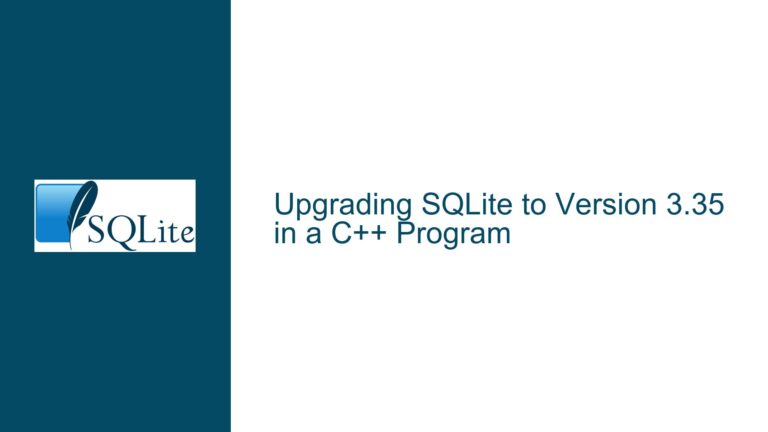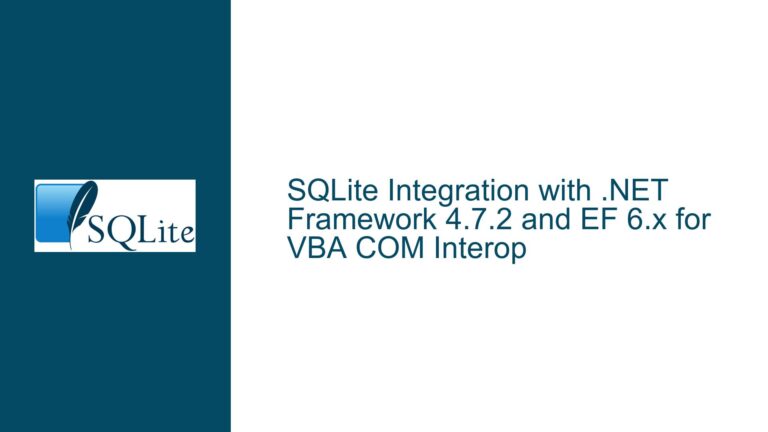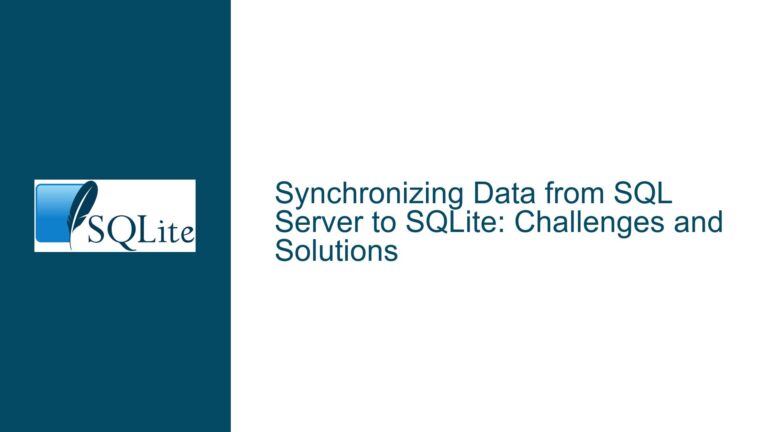Using SQLite In-Memory Databases for Inter-Thread Communication: Efficiency and Alternatives
Inter-Thread Communication via SQLite: Performance and Architectural Tradeoffs
Issue Overview
Using SQLite as a transient in-memory database for inter-thread communication introduces unique challenges related to concurrency, latency, and resource utilization. While SQLite’s reliability and portability make it an appealing candidate for sharing structured data between threads, its design constraints and synchronization mechanisms may conflict with the performance requirements of real-time or high-throughput systems.
At its core, the problem revolves around SQLite’s threading model, transactional guarantees, and polling requirements. In a multi-threaded C application, threads typically operate via separate database connections to avoid locking conflicts. However, SQLite’s update hooks and notifications are connection-specific, meaning modifications from one thread’s connection do not trigger events in another thread’s connection. This forces consumer threads to poll for changes, introducing latency and CPU overhead. Additionally, SQLite’s write-ahead logging (WAL) mode is unavailable for in-memory databases, exacerbating contention between readers and writers.
The architectural tradeoffs become apparent when comparing SQLite-based communication to purpose-built thread-safe queues or semaphores. While SQLite can serialize and persist data reliably, its transactional and query-processing overhead may degrade performance in scenarios requiring rapid data exchange.
Key Factors Impacting SQLite’s Suitability for Thread Communication
1. Concurrency Model and Connection Isolation
SQLite allows multiple threads to access the same database via separate connections but enforces strict locking rules. In-memory databases configured without the shared cache parameter (e.g., file::memory:?cache=shared) are isolated per connection, rendering cross-thread synchronization ineffective. Even with shared caching, write operations acquire exclusive locks, blocking concurrent reads or writes.
2. Polling Overhead vs. Event-Driven Notification
Without native cross-connection event triggers, consumer threads must repeatedly execute queries (e.g., SELECT ... WHERE timestamp > last_processed) to detect new data. Indexed timestamps reduce scan costs, but frequent polling still consumes CPU cycles and introduces latency. Compare this to lock-free queues or semaphores, which allow threads to sleep until signaled, minimizing resource usage.
3. Transactional and Serialization Costs
Every insertion or query in SQLite involves parsing SQL statements, managing transactions, and serializing data. For small, frequent messages (e.g., sensor readings or log entries), these operations accumulate significant overhead. By contrast, in-memory ring buffers or atomic variables bypass serialization entirely, offering nanosecond-level latency.
4. Data Volume and Complexity
SQLite excels at managing structured, relational data with complex query requirements. However, if the inter-thread communication involves simple key-value pairs or unstructured blobs, the relational model introduces unnecessary complexity.
Optimizing SQLite for Thread Communication and Evaluating Alternatives
Step 1: Assess Data Rate and Latency Requirements
- Low-Throughput Scenarios (e.g., <100 events/second): SQLite’s overhead is negligible. Use a shared in-memory database (
file::memory:?cache=shared) with indexed timestamp columns for efficient polling. - High-Throughput Scenarios (e.g., >10,000 events/second): SQLite will struggle due to lock contention and serialization. Transition to a dedicated concurrent queue (e.g.,
concurrentqueuefor C++ or custom lock-free structures in C).
Step 2: Minimize Polling Overhead
- Indexed Queries: Create an index on the timestamp or sequence column used to detect new entries.
CREATE INDEX idx_events_time ON JobQueue(insert_time);
- Batch Processing: Retrieve multiple rows per poll to amortize query costs.
SELECT * FROM JobQueue WHERE processed = 0 LIMIT 100;
- Hybrid Signaling: Combine SQLite with a lightweight semaphore. After inserting data, the producer thread signals the consumer via a semaphore post, reducing polling frequency.
Step 3: Mitigate Lock Contention
- Use Immediate Transactions: Begin write transactions with
BEGIN IMMEDIATEto avoid deadlocks. - Short-Lived Transactions: Keep write transactions open only for the minimal necessary duration.
- Reader Resilience: Configure reader threads to retry queries on
SQLITE_BUSYerrors or use a timeout.
Step 4: Evaluate Alternative Synchronization Mechanisms
- MPMC Queues: For C applications, implement a multi-producer/multi-consumer queue using atomic operations and futexes. Example libraries include
liblfdsor custom ring buffers. - Shared Memory with Semaphores: Map a memory region between threads, using semaphores or condition variables to signal updates.
- Pipe-Based Notification: Use a Unix pipe or socketpair to notify consumers of new data, decoupling signaling from data storage.
Step 5: Benchmark and Compare
- SQLite Baseline: Measure insert/query latency under load using
sqlite3_profileor custom instrumentation. - Alternative Comparison: Benchmark the same workload against a lock-free queue or shared memory. Tools like
perfordtracecan quantify CPU cycles and contention.
Final Recommendation
SQLite is viable for low-rate, structured communication where persistence or complex querying is required. For high-performance scenarios, prefer thread-safe queues or shared memory, reserving SQLite for auxiliary tasks like auditing or recovery logging. Hybrid architectures (e.g., queue for signaling + SQLite for storage) balance responsiveness with durability but require careful synchronization to avoid races.

